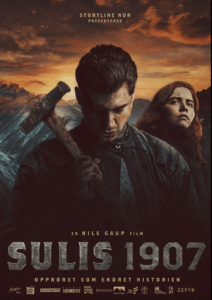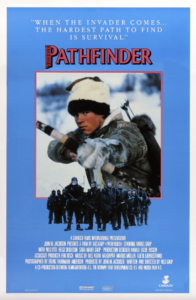ISFI’s new film commissioner is Nils Gaup
Published: 08.05.2023
International Sámi Film Institute is proud to announce our new film commissioner Nils Gaup. Read more about his work, his thoughts on the future of Sámi film, and what advice he gives to future Sámi filmmakers.

With the film Pathfinder (1987), Nils Gaup has shown the way to the future of Sámi films. He is a well-known Sámi filmmaker and has directed films internationally for over 30 years.
– It’s a lot of fun to be part of this process as a film commissioner, and it’s so fun that people want to make films. There are many interesting projects and many different ideas related to Sami culture. A lot will now happen in the Sami film world; Sami series, documentaries, feature films, and games will be made.
Nils Gaup has long been a role model in Sápmi, especially among Sámi filmmakers, since the Pathfinder film came out in 1987. Since then, he has directed 13 feature films and TV series.

This year he is the director of the film Sulis 1907, which Tom Vidar Karlsen, Trond Eliassen, and Christer Nilson produce. The film premieres in the autumn and is now in post-production. Therefore, it is also suitable to work as a film commissioner.
– People have always come up with different thoughts about movies, and I haven’t had time to answer. Now I look forward to answering and delving into this. It’s so interesting, and so much fun, that people want to make films.
He is also a mentor and gives advice to film scripts for Sámi filmmakers. As a film consultant, he must process applications that come to ISFI.
– Now I’m sitting on the other side of the table, and that’s perfectly fine with me.
What is your best advice for Sámi filmmakers?
– Find a topic and idea that is very important and precious to you and something you know you have to tell. Something that only some can tell.
10-year process
It takes time to make a film, and the theme should be something you can work on for almost 30 years.
– When I started working on the Kautokeino-rebellion, this narrative was very important to me. I remember this story from my childhood. Elle Skum was my great-grandmother, and it was crucial for me to tell this story.
It was a long process from idea to film, finding the right comfortable way to tell, and how to get financing. The film’s concept took ten years until the film was published.
Traveling with the story
He grew up in Soahtefielbma in Kautokeino, and as a child and youth, he heard many stories. Oral narratives were familiar before television came to Sápmi.
– Working with Sámi stories is really fun, and I wanted to work with Sámi culture. At that time, there was no theater, so we created Beaivváš. But in theatre, you are on the stage, and you are there six days a week. However, Beaivváš is, of course, a little different. I wanted to travel and experience the world, and film would be a good fit.
So then he started working with films.
There was no television at that time
He reminisces about the time when both young and old told stories.
– I remember these stories well. Everyone told stories. It was our entertainment when we didn’t have television. They used to tell short stories that took ten minutes. We asked them to tell more and more if there were excellent stories. The movie Pathfinder is, after all, many stories made into one movie.
He recalls that when television came, people stopped telling stories, and the storytelling tradition disappeared.
– And the film is a great way to bring back the traditional storytelling tradition. The Pathfinder was precisely aimed at bringing back this storytelling tradition. If we don’t tell our stories ourselves, Sápmi disappears.
Why are Sami films important?
– If we don’t make Sámi films, our culture will disappear. There are stories in every cinema. Netflix has narratives. If we don’t tell our stories, they disappear. Today, children watch television and tv-series. They know more about the Ninjago universe than about our Sámi stories and mythology. If we don’t tell them, others can use our culture.
– And when we have destroyed nature in our world, it is also important to lift the basic Sámi culture that is about to disappear.
Sápmi is a great source
There is much in Sápmi that suits the film. Sápmi is visual, Sámi music, and joik is special. Sápmi is enormous, and there are many different Sámi tales, stories, and traditions throughout Sápmi from south to east.
– Sápmi is an excellent source from which we can gather many stories; Qvikstad and Læstadius have collected several hundred stories.
What is the next big Sámi film and story?
– I don’t have the answer to that. What is good is often a thought and idea that surprises and that no one else has thought of. What you don’t expect, but which suddenly comes.
That is why ISFI is essential.
– With NFI, Norwegian films exist. Therefore it is good that ISFI exists because we can help and support Sámi films.


